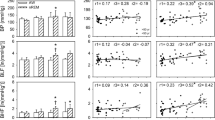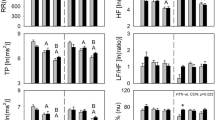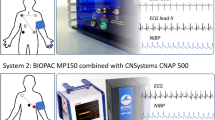Abstract
Background
The baroreflex and central autonomic brain regions together control the cardiovascular system. Baroreflex sensitivity (BRS) decreases with age in adults. Age-related changes in brain regions for cardiovascular control in children are unknown. We studied age-related changes in BRS, cardiac autonomic tone, and gray matter volume (GMV) of brain regions associated with cardiovascular control.
Methods
Beat-to-beat blood pressure and heart rate (HR) were recorded in 49 children (6–14 years old). Spontaneous BRS was calculated by the sequence method. Cardiac autonomic tone was measured by spectral analysis of HR variability. GMV was measured using voxel-based morphometryin 112 healthy children (5–18 years old).
Results
Age-related changes in BRS were significantly different in children <10 years and ≥10 years. Age-related changes in GMV in regions of interest (ROI) were also significantly different between children <10 and ≥10 years and between children <11 and ≥11 years. However, age-related changes in cardiac autonomic tone were progressive.
Conclusions
Significant changes in BRS trajectories between <10 and ≥10 years may be associated with similar age-related changes of GMV in brain ROI. This new knowledge will guide future studies examining whether childhood cardiovascular disruption manifests as deviated maturation trajectories of specific brain regions.
Similar content being viewed by others
Log in or create a free account to read this content
Gain free access to this article, as well as selected content from this journal and more on nature.com
or
References
Giedd JN, Blumenthal J, Jeffries NO et al. Brain development during childhood and adolescence: a longitudinal MRI study. Nat Neurosci 1999;2:861–863.
Luby JL, Belden AC, Jackson JJ et al. Early childhood depression and alterations in the trajectory of gray matter maturation in middle childhood and early adolescence. JAMA Psychiatry 2016;73:31–38.
Walhovd KB, Tamnes CK, Fjell AM . Brain structural maturation and the foundations of cognitive behavioral development. Curr Opin Neurol 2014;27:176–184.
Thillay A, Roux S, Gissot V et al. Sustained attention and prediction: distinct brain maturation trajectories during adolescence. Front Hum Neurosci 2015;9:519.
McLaughlin KA, Fox NA, Zeanah CH, Sheridan MA, Marshall P, Nelson CA . Delayed maturation in brain electrical activity partially explains the association between early environmental deprivation and symptoms of attention-deficit/hyperactivity disorder. Biol Psychiatry 2010;68:329–336.
Matsukawa K . Central command: control of cardiac sympathetic and vagal efferent nerve activity and the arterial baroreflex during spontaneous motor behaviour in animals. Exp Physiol 2012;97:20–28.
Ogoh S, Wasmund WL, Keller DM et al. Role of central command in carotid baroreflex resetting in humans during static exercise. J Physiol 2002;543:349–364.
Kimmerly DS, O'Leary DD, Menon RS, Gati JS, Shoemaker JK . Cortical regions associated with autonomic cardiovascular regulation during lower body negative pressure in humans. J Physiol 2005;569:331–345.
Napadow V, Dhond R, Conti G, Makris N, Brown EN, Barbieri R . Brain correlates of autonomic modulation: combining heart rate variability with fMRI. Neuroimage 2008;42:169–177.
Nagai M, Hoshide S, Kario K . The insular cortex and cardiovascular system: a new insight into the brain–heart axis. J Am Soc Hypertens 2010;4:174–182.
James C, Macefield VG, Henderson LA . Real-time imaging of cortical and subcortical control of muscle sympathetic nerve activity in awake human subjects. Neuroimage 2013;70:59–65.
Kimmerly DS, Morris BL, Floras JS . Apnea-induced cortical BOLD-fMRI and peripheral sympathoneural firing response patterns of awake healthy humans. PLoS ONE 2013;8:e82525.
Thayer JF, Ahs F, Fredrikson M, Sollers JJ III, Wager TD . A meta-analysis of heart rate variability and neuroimaging studies: implications for heart rate variability as a marker of stress and health. Neurosci Biobehav Rev 2012;36:747–756.
Goldstein B, Kempski MH, DeKing D et al. Autonomic control of heart rate after brain injury in children. Crit Care Med 1996;24:234–240.
Kallmunzer B, Breuer L, Kahl N et al. Serious cardiac arrhythmias after stroke: incidence, time course, and predictors—a systematic, prospective analysis. Stroke 2012;43:2892–2897.
Takahashi C, Hinson HE, Baguley IJ . Autonomic dysfunction syndromes after acute brain injury. Handb Clin Neurol 2015;128:539–551.
Lenard Z, Studinger P, Mersich B, Kocsis L, Kollai M . Maturation of cardiovagal autonomic function from childhood to young adult age. Circulation 2004;110:2307–2312.
Ogden CL, Kuczmarski RJ, Flegal KM et al. Centers for Disease Control and Prevention 2000 growth charts for the United States: Improvements to the 1977 National Center for Health Statistics version. Pediatrics 2002;109:45–60.
McConnell K, Somers VK, Kimball T et al. Baroreflex gain in children with obstructive sleep apnea. Am J Respir Crit Care Med 2009;180:42–48.
Bertinieri G, Di Rienzo M, Cavallazzi A, Ferrari AU, Pedotti A, Mancia G . Evaluation of baroreceptor reflex by blood pressure monitoring in unanesthetized cats. Am J Physiol 1988;254:H377–H383.
Legramante JM, Marciani MG, Placidi F et al. Sleep-related changes in baroreflex sensitivity and cardiovascular autonomic modulation. J Hypertens 2003;21:1555–1561.
Ashburner J, Friston KJ . Voxel-based morphometry—the methods. Neuroimage 2000;11:805–821.
Gaser C VBM8. Jena, Germany: University of Jena.
Ashburner J, Friston KJ . Unified segmentation. Neuroimage 2005;26:839–851.
Ashburner J . A fast diffeomorphic image registration algorithm. Neuroimage 2007;38:95–113.
Manjon JV, Coupe P, Marti-Bonmati L, Collins DL, Robles M . Adaptive non-local means denoising of MR images with spatially varying noise levels. J Magn Reson Imag 2010;31:192–203.
Rajapakse JC, Giedd JN, Rapoport JL . Statistical approach to segmentation of single-channel cerebral MR images. IEEE Trans Med Imaging 1997;16:176–186.
Toms JD, Lesperance ML . Piecewise regression: a tool for identifying ecological thresholds. Ecology 2003;84:2034–2041.
Garcia R, Sosner P, Laude D, Hadjadj S, Herpin D, Ragot S . Spontaneous baroreflex sensitivity measured early after acute myocardial infarction is an independent predictor of cardiovascular mortality: results from a 12-year follow-up study. Int J Cardiol 2014;177:120–122.
De Ferrari GM, Sanzo A, Bertoletti A, Specchia G, Vanoli E, Schwartz PJ . Baroreflex sensitivity predicts long-term cardiovascular mortality after myocardial infarction even in patients with preserved left ventricular function. J Am Coll Cardiol 2007;50:2285–2290.
Johansson M, Gao SA, Friberg P et al. Baroreflex effectiveness index and baroreflex sensitivity predict all-cause mortality and sudden death in hypertensive patients with chronic renal failure. J Hypertens 2007;25:163–168.
Monahan KD . Effect of aging on baroreflex function in humans. Am J Physiol Regul Integr Comp Physiol 2007;293:R3–R12.
Piccirillo G, Di Giuseppe V, Nocco M et al. Influence of aging and other cardiovascular risk factors on baroreflex sensitivity. J Am Geriatr Soc 2001;49:1059–1065.
Monahan KD, Dinenno FA, Seals DR, Clevenger CM, Desouza CA, Tanaka H . Age-associated changes in cardiovagal baroreflex sensitivity are related to central arterial compliance. Am J Physiol Heart Circ Physiol 2001;281:H284–H289.
Dinenno FA, Jones PP, Seals DR, Tanaka H . Age-associated arterial wall thickening is related to elevations in sympathetic activity in healthy humans. Am J Physiol Heart Circ Physiol 2000;278:H1205–H1210.
Piccirillo G, Cacciafesta M, Viola E et al. Influence of aging on cardiac baroreflex sensitivity determined non-invasively by power spectral analysis. Clin Sci (Lond) 2001;100:267–274.
Ramaekers D, Ector H, Aubert AE . The influence of age and gender on heart rate variability (HRV). J Am Coll Cardiol 1999;33:900–902.
Almeida-Santos MA, Barreto-Filho JA, Oliveira JL, Reis FP, da Cunha Oliveira CC, Sousa AC . Aging, heart rate variability and patterns of autonomic regulation of the heart. Arch Gerontol Geriatr 2016;63:1–8.
Matsukawa T, Sugiyama Y, Mano T . Age-related changes in baroreflex control of heart rate and sympathetic nerve activity in healthy humans. J Auton Nerv Syst 1996;60:209–212.
Huang CC, Sandroni P, Sletten DM, Weigand SD, Low PA . Effect of age on adrenergic and vagal baroreflex sensitivity in normal subjects. Muscle Nerve 2007;36:637–642.
Baird AA, Gruber SA, Fein DA et al. Functional magnetic resonance imaging of facial affect recognition in children and adolescents. J Am Acad Child Adolesc Psychiatry 1999;38:195–199.
Author information
Authors and Affiliations
Corresponding author
Ethics declarations
Competing interests
The authors declare no conflict of interest.
Additional information
STATEMENT OF FINANCIAL SUPPORT
This study was supported by a National Institutes of Health grant (R01 HL080670) and Clinical Translational Research Center (MO1RR 08084-08), Cincinnati Children’s Hospital.
Rights and permissions
About this article
Cite this article
DiFrancesco, M., Shamsuzzaman, A., McConnell, K. et al. Age-related changes in baroreflex sensitivity and cardiac autonomic tone in children mirrored by regional brain gray matter volume trajectories. Pediatr Res 83, 498–505 (2018). https://doi.org/10.1038/pr.2017.273
Received:
Accepted:
Published:
Issue date:
DOI: https://doi.org/10.1038/pr.2017.273
This article is cited by
-
Effects of age and sex on vasomotor activity and baroreflex sensitivity during the sleep–wake cycle
Scientific Reports (2022)
-
Arterial Baroreceptor Physiology: Differences Between Normal Subjects and Pediatric Patients with Postural Tachycardia and Neurocardiogenic Syncope
Pediatric Cardiology (2022)
-
Baroreceptor activity and sensitivity: normal values in children and young adults using the head up tilt test
Pediatric Research (2019)



